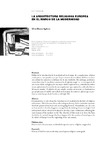La arquitectura religiosa europea en el marco de la modernidad

Ver/
Use este enlace para citar
http://hdl.handle.net/2183/11991Coleccións
Metadatos
Mostrar o rexistro completo do ítemTítulo
La arquitectura religiosa europea en el marco de la modernidadAutor(es)
Data
2011Cita bibliográfica
Boletín Académico. Revista de investigación y arquitectura contemporánea, 2011, 1: 18-26. ISSN: 2173-6723
Resumo
[Resumen] Hablar de la introducción de la modernidad en el campo de la arquitectura religiosa puede parecer una paradoja, ya que los promotores de esta última debían mantener una actitud de custodia y continuación de una tradición. Sin embargo, podremos comprobar cómo la moderna construcción de iglesias surgió de la convergencia de una nueva visión teológica y de una nueva visión arquitectónica, coincidentes ambas en sus aspiraciones: la creación de una arquitectura que captase las cualidades básicas del nuevo mundo. El objetivo de este estudio consiste en mostrar los fundamentos que propiciaron el cambio tan radical en la manera de construir iglesias que se produjo en toda Europa desde los inicios del siglo XX. [Abstract] It is paradoxical to talk about the introduction of modernity in the field of religious architecture. This is because those advocating modernity had to maintain a posture that boThpreserved tradition and kept it going forward. Nevertheless, we can now see how modern churches began to emerge from the joining of new theological and architectural visions which boThaimed to develop a new architecture reflecting the basic features of the modern world. The objective of this study is to show the facts that led to the radical changes that have happened in the creation of sacred spaces in the whole of Europe from the beginning of the last century.
Palabras chave
Historia de la arquitectura
Modernidad
Espacios sacros
Religión
Vanguardias
History of architecture
Modernity
Sacred space
Religion
Avant-garde
Modernidad
Espacios sacros
Religión
Vanguardias
History of architecture
Modernity
Sacred space
Religion
Avant-garde
ISSN
2173-6723





